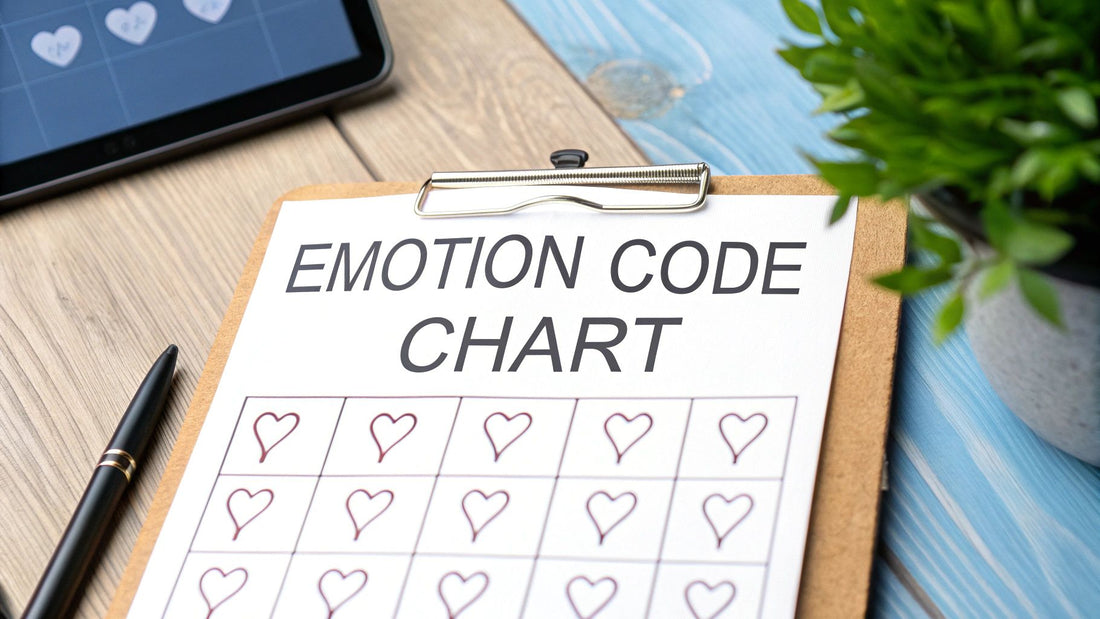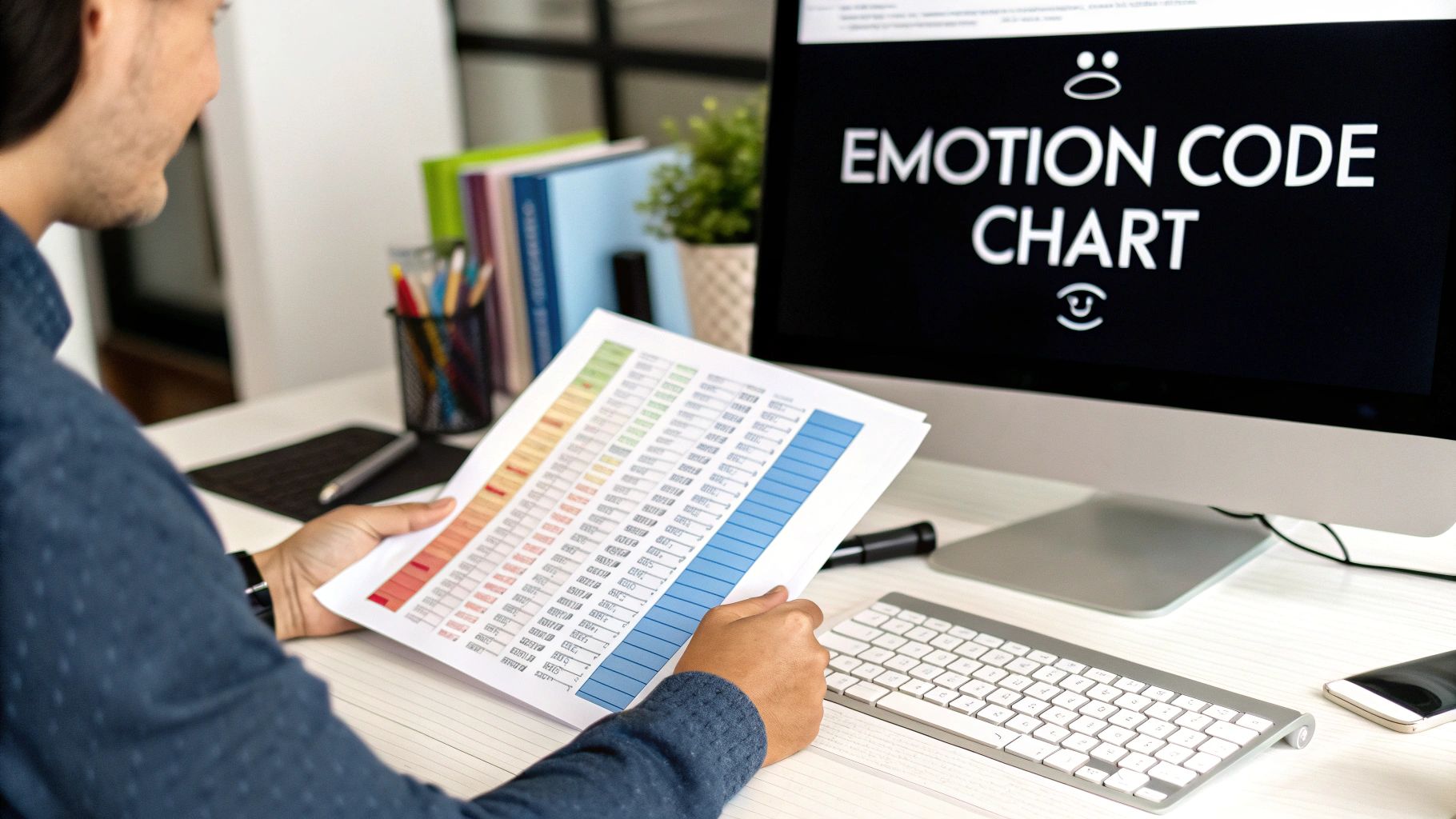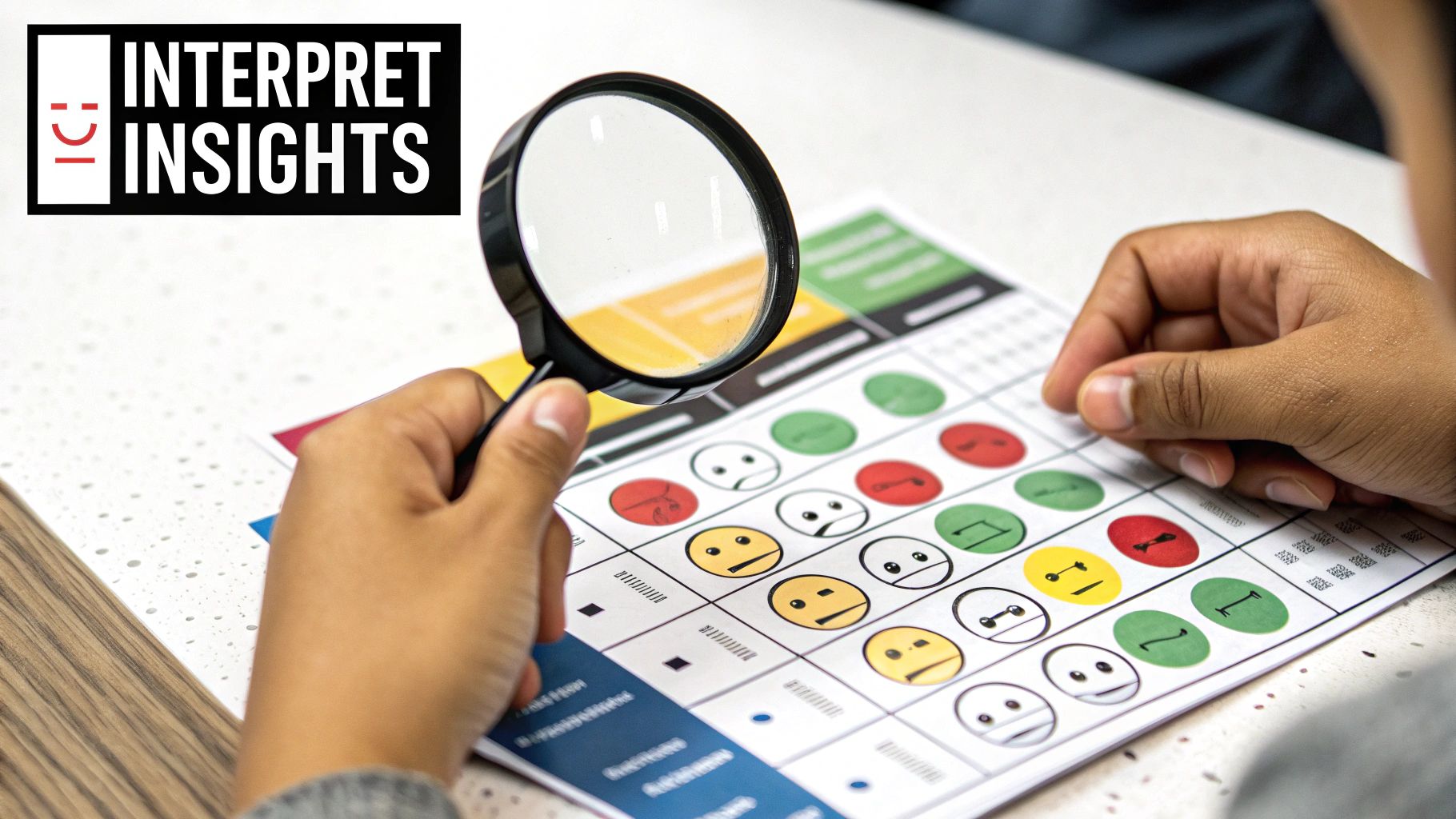
Your Guide to the Emotion Code Chart
Share
Ever heard of the Emotion Code Chart? It's a fascinating tool, rather like a roadmap for your feelings. The idea behind it is to help you find and let go of what are called 'trapped emotions'—those old emotional energies that can get stuck and quietly interfere with your physical and mental wellbeing.
Navigating the Mind-Body Connection

The chart was developed by Dr Bradley Nelson, and it's built on a simple but powerful principle: our emotional turmoil can bubble up to the surface as real-world symptoms. It’s all about that deep connection between what’s going on in our heads and what we feel in our bodies.
This connection is more important now than ever, especially for our children. With the pressures of school and the pervasive influence of social media, it's no surprise that in the UK, a staggering one in five children now has a probable mental health condition. We need to tackle these things early on. It's not just about individual wellbeing, either; poor mental health costs UK businesses up to £56 billion a year in lost productivity.
Fostering Emotional Awareness
This is where tools that help build emotional literacy can make a real difference. They start conversations and make it easier for everyone, no matter their age, to talk about how they’re feeling. Even simple things like deep breathing or a moment of mindfulness can offer a bit of relief when stress feels overwhelming.
There are lots of ways to get the conversation started:
- Mental Health Apparel: Something as simple as clothing with a positive message can help make talking about mental wellbeing feel normal and less stigmatised.
- Insightful Books: Reading together can open up a whole new world of understanding. Learning the story behind a children's mental health book, for example, can give parents some really valuable perspective.
Just a quick and important note: I am not a mental health professional. This guide is just to share information and should not be a substitute for proper medical advice. If you have any worries about your own or your child's health, please chat with a doctor or your GP.
How to Read the Emotion Code Chart
At first glance, the Emotion Code chart can look a little complex, but it’s actually designed to be incredibly straightforward. It lays out 60 common emotions in a simple grid with two columns (Column A and Column B) and six rows. This whole structure is built for a simple process of elimination, often using muscle testing to get clear 'yes' or 'no' answers directly from the body.
The idea is to keep asking questions to narrow down the options until you land on one specific trapped emotion. You might start by asking which column the emotion is in, then which row, and finally, which of the five emotions in that little box is the one that needs attention. It’s a method that turns a busy-looking diagram into a clear, step-by-step guide for emotional discovery.
Understanding the Grid Layout
The chart’s real magic is in its layout. It’s designed to systematically guide your focus from a wide-open field of possibilities down to a single, specific feeling. The Emotion Code itself, developed by Dr Bradley Nelson, is all about releasing these 'trapped emotions', which he believes are balls of energy that can get stuck in the body and cause trouble.
According to his work, these lingering energies can show up as both physical aches and emotional blocks down the line. If you're curious about the theory behind it, you can explore Dr. Nelson’s findings on the Emotion Code.
To get a better sense of how these emotional energies work, this diagram shows how feelings can be grouped by their intensity.

This visual helps us realise that emotional energy isn't all the same; it can range from quiet, background feelings to intense states that you just can't ignore. Figuring out where an emotion sits on this spectrum gives you valuable context for what’s going on.
Navigating the chart is a bit like being a detective for your own feelings. Each question you ask narrows the search, bringing you closer to the specific emotional clue that holds the key.
This systematic approach takes the guesswork out of the process. It transforms what could be a confusing experience into a focused investigation, helping you or your client pinpoint exactly what needs to be acknowledged and finally let go.
The table below breaks down the grid structure to give you a clearer picture of how it all fits together.
Navigating the Emotion Code Chart Grid
This table shows a simplified layout of the chart, illustrating how 60 emotions are organised into two columns and six rows for easy identification.
| Row | Column A Emotions (Example) | Column B Emotions (Example) |
|---|---|---|
| 1 | Abandonment, Betrayal, etc. | Crying, Discouragement, etc. |
| 2 | Anxiety, Despair, etc. | Confusion, Defensiveness, etc. |
| 3 | Failure, Helplessness, etc. | Grief, Self-Abuse, etc. |
| 4 | Hopelessness, Lack of Control, etc. | Depression, Frustration, etc. |
| 5 | Overwhelm, Panic, etc. | Humiliation, Jealousy, etc. |
| 6 | Worthlessness, Worry, etc. | Longing, Lust, etc. |
By following this simple map of two columns and six rows, you can methodically work your way to the core emotion that needs addressing, making the entire process feel manageable and clear.
The Link Between Your Body and Emotions

The idea that emotions can get ‘trapped’ inside us might sound a bit metaphorical, but it’s actually rooted in the very real, powerful connection between our minds and our bodies. It’s the reason a persistent ache in your shoulder might feel tied to a heavy emotional burden, or why anxiety often shows up as a tight knot in your stomach.
This connection between how we feel emotionally and what we feel physically is profound. If you look into things like the intricate gut microbiota brain axis, you'll see just how deeply our physical health can influence our mental and emotional states. This perspective helps make the whole idea behind the emotion code chart feel much more tangible and less abstract.
Bodily Maps of Emotions
Science has actually started mapping out how all of this works. There’s some fascinating research on ‘bodily maps of emotions’, which shows how feelings like joy, anger, and fear trigger distinct physical sensations in very predictable areas of the body.
One landmark study from 2013, for instance, revealed that different emotions create specific patterns of bodily sensation. Happiness was consistently felt as an increased energy in the chest and face, while sadness and fear created entirely different physical maps. It’s a fascinating read if you want to dive deeper.
When we understand this, it provides a logical foundation for how releasing an emotion can bring about real physical relief. Helping children understand where they feel their emotions is a crucial life skill. You can learn more about teaching emotional awareness to children in our related guide.
By acknowledging that an emotion has a physical presence, we can begin to address it. This validates a child's experience, showing them that what they feel in their body is real and important.
Using the Chart for Emotional Release

So, how do we actually put the emotion code chart to use? The whole idea revolves around talking to your subconscious mind, usually through a simple technique called applied kinesiology, or muscle testing. It’s a way of getting straightforward ‘yes’ and ‘no’ answers directly from your body.
Think of it as opening a direct line to your inner self, bypassing the conscious part of your brain that loves to overthink, analyse, and rationalise everything. This connection lets you ask specific questions to navigate the chart and zero in on a particular trapped emotion that’s asking for your attention.
It's a gentle, intuitive process of elimination. You’re simply creating a calm, safe space to explore what might be going on under the surface, without any pressure or judgement. The focus is always on gentle discovery and release.
A Practical Example with a Child
Let’s imagine your little one comes home from school and seems unusually quiet and withdrawn. They might not have the words to tell you what’s wrong, but you can feel there’s a deep-seated anxiety there. This is a perfect moment where the chart can become a bridge for communication.
Here’s a simple way to approach it:
- Create a Calm Space: Find a comfy spot where you won’t be interrupted. Sit together and take a few deep, calming breaths to get settled. A simple relaxation technique is to slowly breathe in for four counts, hold for four, and breathe out for six.
- Establish a Baseline: Using muscle testing (or a similar method), ask some easy questions you already know the answer to, like, "Is your name [Child's Name]?" This helps you see what a clear ‘yes’ response feels like.
- Ask Navigational Questions: Start with the big picture. You could ask, "Is there a trapped emotion connected to your day at school?" If the answer is ‘yes’, you can turn to the chart.
- Narrow It Down: Move through the chart systematically. "Is this emotion in Column A?" followed by, "Is it in an odd-numbered row?" Keep going like this until you pinpoint a specific emotion, maybe ‘Anxiety’ or ‘Worry’.
Just by giving the feeling a name, you’ve opened the door to a real conversation. It validates their experience and makes them feel seen and understood. That alone is a huge step towards releasing that stuck energy and building their emotional resilience.
Important Disclaimer: Please remember, I am not a mental health professional. This guide is for informational purposes only and is not a substitute for professional medical advice. If you are worried about your own or your child’s mental health, it is essential to seek guidance from your GP or a qualified therapist.
Helping Children Navigate Their Emotions
It’s no secret that there are growing worries about children's mental health here in the UK. With the added pressures of social media, it feels more important than ever to give our kids the tools to understand their inner world. One in five children now has a probable mental health condition, a figure that highlights the urgency of addressing these issues openly and early.
This is where something like an emotion code chart can be a gentle, visual helping hand. It's a way for children to point to a feeling they might not have the words for yet.
Think of it less as a diagnostic tool and more as a way to build a shared language of feelings. You can use the chart to open up conversations about tricky things like friendship troubles or exam stress, helping them put a name to the big, confusing sensations they're experiencing inside.
When a child can name their emotion, they feel seen and understood. It validates their experience. In more complex scenarios, professionals actually use standardised coding systems to interpret emotions. For instance, the EmoCodes system looks at basic emotions like anger, happiness, and sadness – feelings that most children in the UK and around the world learn to recognise quite early on. You can read more about how emotions can be systematically coded.
By encouraging this kind of awareness, you're not just helping them in the moment; you're building a foundation of resilience and emotional intelligence for their entire life.
Building Emotional Resilience
Creating a safe, calm space for these chats is everything. It can be as simple as taking a few deep, calming breaths together before you even look at the chart. This small step can make the whole experience feel supportive and safe, rather than like a test.
The real goal is to empower them with skills they can carry with them as they grow. This kind of proactive approach to their wellbeing can make a world of difference. There are so many simple but powerful ways you can support your child's mental health journey.
A Gentle Reminder: As I've mentioned, I am not a mental health professional. This is for informational purposes only. If you are ever worried about a child's mental health, please seek help from a doctor or GP.
The Journey Doesn't Stop Here
Working with tools like the Emotion Code Chart is a brilliant first step, but it’s just that—a step. True emotional wellbeing isn't a destination you arrive at, but a path you continue to walk. To make the journey a little easier, it helps to build a personal toolkit of resources that can bring you comfort, insight, and a sense of connection.
It's so important that we talk about and work on our mental health. It’s not just a personal thing; it ripples out into society. Here in the UK, poor mental health costs businesses up to a staggering £56 billion every single year. That figure alone shows just how widespread the impact of emotional struggle is, and why nurturing our own wellbeing is one of the best investments we can make.
As you continue on your own path, finding others who are on a similar wavelength can be incredibly powerful. If you've ever wondered what it takes to create these kinds of supportive spaces, you might find this guide on how online communities are built quite interesting.
Small Resources for Your Daily Wellbeing
Bringing small, consistent practices into your daily life can make a world of difference. The idea is to weave simple habits into your routine that support you day-to-day, especially when dealing with the pressures of modern life—which are so often cranked up to ten by social media.
Here are a few ideas to get you started:
- Mindful Moments: Just take five minutes. Find a quiet spot and focus on your breathing. A simple pattern is to breathe in for four counts, hold it gently for four, and then breathe out slowly for six. It's a fantastic way to quickly calm your nervous system.
- Wear Your Heart on Your Sleeve (Literally!): Things like mental health apparel can be a lovely way to normalise conversations around our feelings. It’s a small, visible reminder to be a little kinder to yourself and to those around you.
- A Good Read: Getting lost in a book that explores the connection between our minds and bodies can be so empowering. When you start to understand the ‘why’ behind your feelings, it can feel like a light has been switched on, for both adults and kids.
A Quick but Important Note: I want to be crystal clear that I am not a mental health professional. The information I share is for educational purposes and isn't a replacement for proper medical advice. If you or someone you know is going through a tough time, please, please reach out to your GP. They are the best person to help you find the right support and guide you forward.
A Few Common Questions
Here are the answers to some of the questions I get asked most often about using the Emotion Code Chart. It’s important to remember that I’m not a mental health professional, and this is purely informational. If you’re worried about your own or your child's wellbeing, please do chat with a doctor.
Do I Need a Practitioner to Use the Chart?
Not necessarily. Lots of people learn to use the chart for themselves and their families, and that’s wonderful. However, a certified practitioner can really help guide you through the process and facilitate much deeper sessions.
If you’re just starting out or feel a bit overwhelmed by it all, working with a professional is a brilliant way to begin your journey.
Is Muscle Testing the Only Way to Do It?
Applied kinesiology (or muscle testing) is definitely the most common method you’ll see used with the Emotion Code Chart. But it’s not the only one. Some people prefer using other intuitive tools, like a pendulum, to get ‘yes’ or ‘no’ answers from the body's subconscious mind and navigate the chart.
How Often Should I Use It?
There’s no hard and fast rule here. Some people reach for the chart when they feel emotionally stuck or notice a specific physical niggle that won’t go away. Others might do a session weekly as a kind of emotional tune-up.
The most important thing is to listen to your body and not overdo it. Always give yourself plenty of time to process what comes up between sessions.
At Little Fish Books, we believe in nurturing emotional literacy right from the start. We create books and resources designed to support children's mental wellbeing in a gentle, colourful way. Discover our full range at thatsokay.co.uk.
